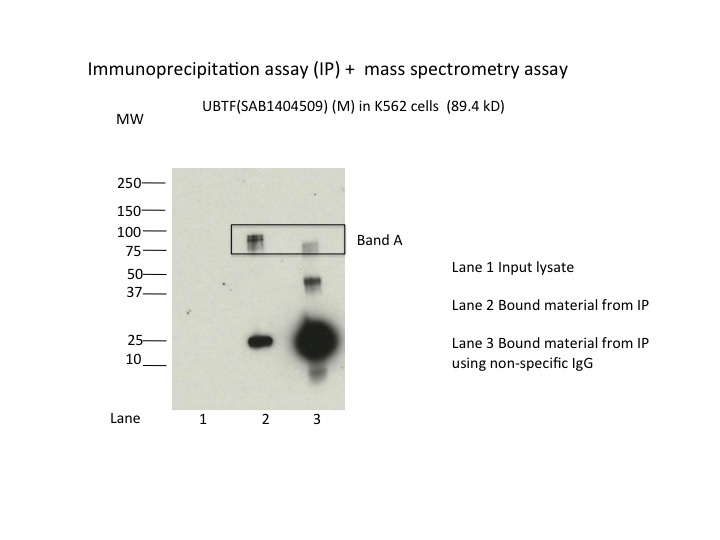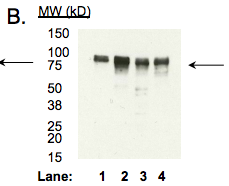ENCAB000AME
Antibody against Homo sapiens UBTF
Homo sapiens
GM12878, K562, HeLa-S3, HepG2
characterized to standards
Homo sapiens
any cell type or tissue
partially characterized
- Status
- released
- Source (vendor)
- Sigma
- Product ID
- SAB1404509
- Lot ID
- 07219-A2
- Characterized targets
- UBTF (Homo sapiens)
- Host
- mouse
- Clonality
- monoclonal
- Antigen description
- immunogen:UBTF (NP_055048, 551 a.a. ~ 651 a.a) partial recombinant protein with GST tag.
- External resources
Characterizations
UBTF (Homo sapiens)
not submitted for review by lab
- Caption
- Immunoprecipitation was performed on nuclear extracts from the cell line: HEK293T, using the antibody SAB1404509. The blot shows western blot analysis of input, flowthrough, immunoprecipitate and mock immunoprecipitate using IgG.Molecular Weight: 89.4
- Submitted by
- Nathaniel Watson
- Lab
- Michael Snyder, Stanford
- Grant
- U54HG006996
- Download
- Expt1121_6-UBTF-SAB1404509.JPG
UBTF (Homo sapiens)
Method: immunoprecipitation
not reviewed
- Caption
- Because the overlap of the top 40% of peaks from datasets derived from antibodies sc-13125 and SAB1404509 (compared using standard ENCODE scoring methods) exceeds the recommended threshold of 80%, both antibodies meet this criterion for validation.
- Submitted by
- Michael Snyder
- Lab
- Michael Snyder, Stanford
- Grant
- U54HG004558
UBTF (Homo sapiens)
Method: ChIP-seq comparison
not reviewed
- Caption
- Using antibody SAB1404509 or sc-13125, we observe a major band in Western blots on lysates from cell lines K562, HeLa S3, HepG2, and, at lower intensity, GM12878 that migrates at a position consistent with the predicted size (~89kD) of UBF/UBTF (Panels A,B). This band is specifically immunoprecipitated from K562 lysates by each antibody (Panels C,D). Based on this, SAB1404509 and sc-13125 are validated by this criterion.
- Submitted by
- Michael Snyder
- Lab
- Michael Snyder, Stanford
- Grant
- U54HG004558
UBTF (Homo sapiens)
K562
compliant
- Caption
- Immunoprecipitation was performed on nuclear extracts from the cell line K562 using the antibody SAB1404509. Lane 1: input nuclear lysate. Lane 2: material immunoprecipitated with antibody. Lane 3: material immunoprecipitated using control IgG. Marked bands were excised from gel and subjected to analysis by mass spectrometry. Target molecular weight: 89.4.
- Submitted by
- Nathaniel Watson
- Lab
- Michael Snyder, Stanford
- Grant
- U54HG006996
- Download
- UBTF.jpg
UBTF (Homo sapiens)
Method: immunoprecipitation followed by mass spectrometry
compliant
- Caption
- IP followed by mass spectrometry. Briefly, protein was immunoprecipitated from K562 nuclear cell lysates using the antibody SAB1404509, and the IP fraction was loaded on a 10% polyacrylamide gel (NuPAGEBis-Tris Gel) and separated with an Invitrogen NuPAGE electrophoresis system. The gel was stained by ColloidialCoomassie G-250 stain, gel fragments corresponding to the bands indicated were excised. Then proteins were trypsinized using the in-gel digestion method. Digested proteins were analyzed on an Orbitrap Elite mass spectrometer (Thermo Scientific) by the nanoLC-ESI-MS/MS technique. Peptides were identified by the SEQUEST algorithm and filtered with a high confidence threshold (Peptide false discovery rate < 1%, 2 unique peptides per protein minimum, mass error < 10 ppm).
- Submitted by
- Nathaniel Watson
- Lab
- Michael Snyder, Stanford
- Grant
- U54HG006996
- Download
- UBTF_SAB1404509 final.pdf
UBTF (Homo sapiens)
GM12878K562HeLa-S3HepG2
compliant
- Caption
- B. Western blot using antibody SAB1404509 on nuclear lysates from cell lines GM12878 (Lane1), K562 (Lane2), HeLaS3 (Lane3), and HepG2 (Lane4). Expected band size is 97 kD. Arrow indicates band of expected size (97 kD) that is highly enriched in the specifically immunoprecipitated fraction.
- Submitted by
- Kathrina Onate
- Lab
- Michael Snyder, Stanford
- Grant
- U54HG004558
- Download
- WB Snyder AME.png

